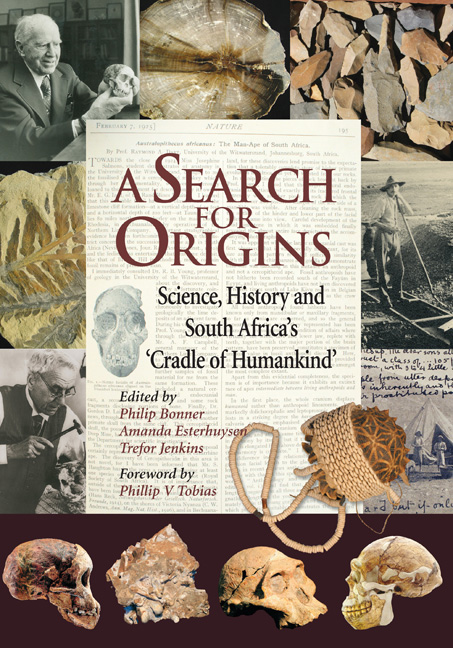Book contents
- Frontmatter
- Contents
- Map
- Foreword
- PART 1 Introduction: Africa is Seldom What It Seems
- PART 2 Introduction: Fossils and Genes: A New Anthropology of Evolution
- Chapter 2 A History of South African Palaeoanthropology
- Chapter 3 Fossil Hominids of the ‘Cradle of Humankind’
- Chapter 4 Unravelling the History of Modern Humans in Southern Africa: The Contribution of Genetic Studies
- Chapter 5 Fossil Plants from the ‘Cradle of Humankind’
- PART 3 Introduction: The Emerging Stone Age
- PART 4 Introduction: The Myth of the Vacant Land
- PART 5 Introduction: The Racial Paradox: Sterkfontein, Smuts and Segregation
- Epilogue: Voice of Politics, Voice of Science: Politics and Science After 1945
- Notes, references and recommended reading
- Notes on contributors
- Acknowledgements
- Index
Chapter 4 - Unravelling the History of Modern Humans in Southern Africa: The Contribution of Genetic Studies
from PART 2 - Introduction: Fossils and Genes: A New Anthropology of Evolution
Published online by Cambridge University Press: 31 May 2019
- Frontmatter
- Contents
- Map
- Foreword
- PART 1 Introduction: Africa is Seldom What It Seems
- PART 2 Introduction: Fossils and Genes: A New Anthropology of Evolution
- Chapter 2 A History of South African Palaeoanthropology
- Chapter 3 Fossil Hominids of the ‘Cradle of Humankind’
- Chapter 4 Unravelling the History of Modern Humans in Southern Africa: The Contribution of Genetic Studies
- Chapter 5 Fossil Plants from the ‘Cradle of Humankind’
- PART 3 Introduction: The Emerging Stone Age
- PART 4 Introduction: The Myth of the Vacant Land
- PART 5 Introduction: The Racial Paradox: Sterkfontein, Smuts and Segregation
- Epilogue: Voice of Politics, Voice of Science: Politics and Science After 1945
- Notes, references and recommended reading
- Notes on contributors
- Acknowledgements
- Index
Summary
Anthropological genetics in South Africa
Raymond Dart, in his writings as well as in the influence he exerted on his students, exhibited a deep interest in the earliest history of the living peoples of southern Africa. Using the methods of his time, Dart searched for pure strains, physical types and racial features among various populations. Accompanied by distinguished scholars like LF Maingard, P Kirby, CM Doke, ID MacCrone and Dorothea Bleek, Dart led an expedition to the Kalahari in 1936, spending a month working among the? Auni≠Khomani San in the northern Cape province (now the Northern Cape), where it borders on Botswana and Namibia. Face masks were made and photographs were taken of seventyseven individuals and are still housed at the Wits Medical School, where they are referred to as the Dart Collection. In addition, genealogical information was collected from each individual, every conceivable measurement was taken and their non-metrical cephalic features were recorded.
Adopting the typological approach popular at the time, Dart (1937a, b) advanced the opinion that the San exhibited Mongoloid, Armenoid and Mediterranean features, in addition to the Bush and ‘Boskopoid’ features which, in his view, predominated in the ‘Bushmen and Hottentot peoples of today’. It was some years before the Cape Town anthropologist Ronald Singer exploded the myth of the Boskop ‘race’ (Singer 1958). The typological approach has been superseded by the methods and techniques of population genetics.
When the Viennese scientist Karl Landsteiner demonstrated in 1900 that all human beings could be assigned to one of a small number of blood groups by a simple test on their red blood cells, he opened up a field of research which continued and expanded throughout the twentieth century. The genetic diversity exhibited by the peoples of southern Africa became an interest of South African medical practitioners as early as 1921, undoubtedly because of its relevance to blood transfusion practice. The studies came within a couple of years of the demonstration in 1919 by Ludwig Hirschfeld and his wife, Hannah, that the frequencies of the genes determining the ABO blood groups varied between populations (Hirschfeld & Hirschfeld 1919).
- Type
- Chapter
- Information
- A Search for OriginsScience, History and South Africa's ‘Cradle of Humankind’, pp. 78 - 90Publisher: Wits University PressPrint publication year: 2007

